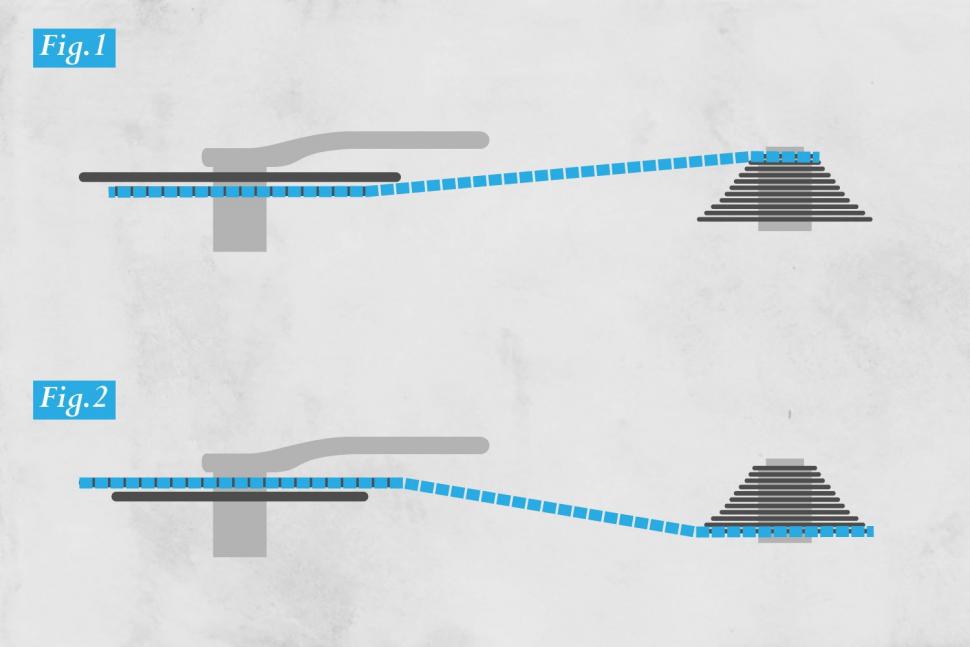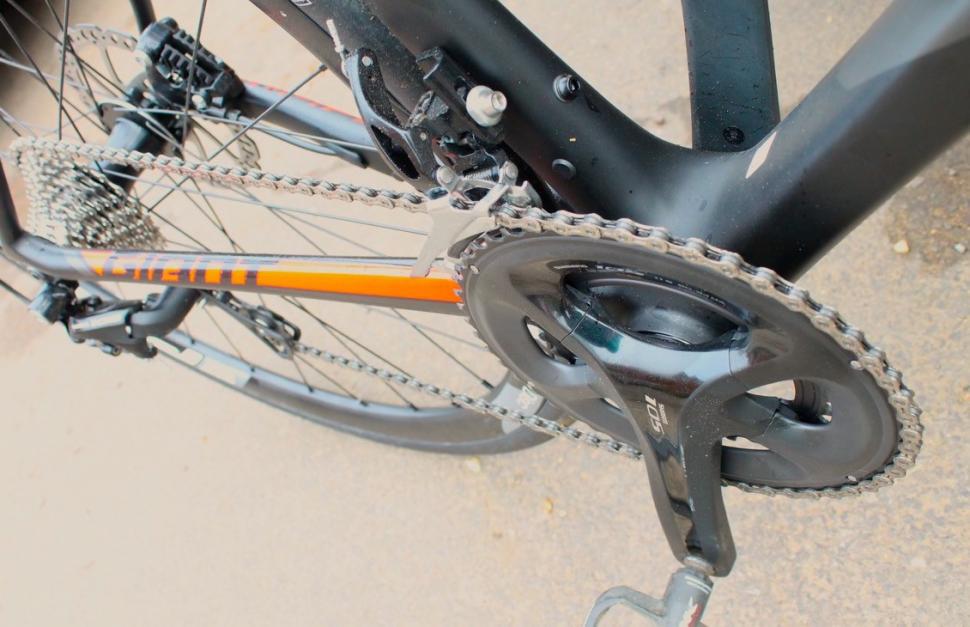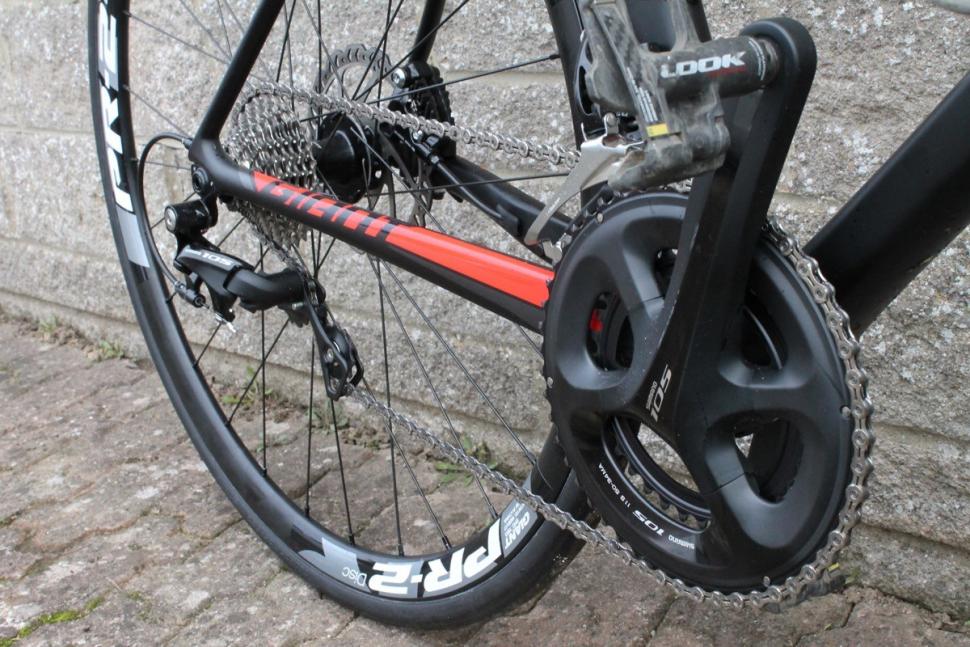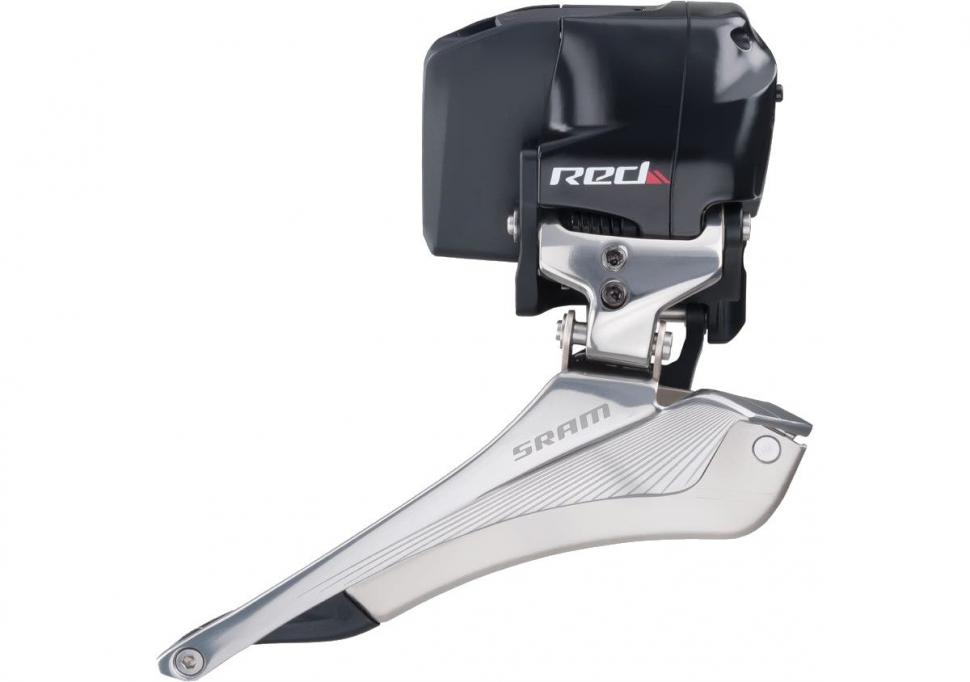- News
- Reviews
- Bikes
- Accessories
- Accessories - misc
- Computer mounts
- Bags
- Bar ends
- Bike bags & cases
- Bottle cages
- Bottles
- Cameras
- Car racks
- Child seats
- Computers
- Glasses
- GPS units
- Helmets
- Lights - front
- Lights - rear
- Lights - sets
- Locks
- Mirrors
- Mudguards
- Racks
- Pumps & CO2 inflators
- Puncture kits
- Reflectives
- Smart watches
- Stands and racks
- Trailers
- Clothing
- Components
- Bar tape & grips
- Bottom brackets
- Brake & gear cables
- Brake & STI levers
- Brake pads & spares
- Brakes
- Cassettes & freewheels
- Chains
- Chainsets & chainrings
- Derailleurs - front
- Derailleurs - rear
- Forks
- Gear levers & shifters
- Groupsets
- Handlebars & extensions
- Headsets
- Hubs
- Inner tubes
- Pedals
- Quick releases & skewers
- Saddles
- Seatposts
- Stems
- Wheels
- Tyres
- Health, fitness and nutrition
- Tools and workshop
- Miscellaneous
- Tubeless valves
- Buyers Guides
- Features
- Forum
- Recommends
- Podcast
feature
 crosschain.jpg
crosschain.jpgIs cross-chaining disastrous? Find out what the manufacturers say
Generations of cyclists have known that cross-chaining is A Bad Thing. It's one of those rules you get taught very early on. Ride with the chain on the small chainring (on the chainset, the component your pedals are attached to) and the smallest sprocket on the cassette (the cluster of cogs attached to the hub of the rear wheel) – as in fig 1 above – or on the large chainring and the largest sprocket – as in fig 2 – and anyone you're riding with is likely to alert you to the fact in seconds. People love to point it out.
But is cross-chaining really all that bad, or does it just get a bad rap? We asked some of the biggest component manufacturers for their views. You might be surprised at some of the things they said.
Read more: When should I replace my chain?
Shimano
The most efficient chain line occurs when the chain is running in a straight line. This minimises friction. When you run big-big you're pushing an uneven power transmission to the rollers, plates and bushings, especially at the points where the chain line alters (the points where the chain meets the sprocket and the chainring). This uneven load causes extra friction which increases the wear on the chain and longer term leads to less than optimum gear shifting.
For these reasons Shimano recommends avoiding extreme gear positions.
Ben Hillsdon, PR Officer, Shimano Europe
Shimano says you should avoid running the chain in this big-big combination (above).
Campagnolo
Cross-chaining is a practice to be avoided as it is less efficient than a straighter chainline (increased friction, less free motion of links etc).
We all might find ourselves cross-chaining during the heat of the battle during a race. However, we shouldn't make a habit out of it as there is generally a similar metric development gearing position available on a larger/smaller chainring.
Extreme chain crossing can add wear and tear on chainring and cassette teeth as the severe angle of the chain brings the external or internal part of the chain in direct contact with chainring/cassette teeth as opposed to a straight chainline which keeps friction to a minimum and limits contact to the rollers located on the axles of each chainlink.
Joshua Riddle, Press Manager, Campagnolo
Read our guide to understanding gears.
SRAM
At SRAM we love big-big. Amongst mechanics on the NORBA and Mountain Bike World Cup circuit (many years ago!), we called big-big the 'pro gear’, because professionals would ride it all the time, no matter what their mechanics told them. The same applies to pro road racers. They'll stay on the big ring as long as possible.
There are very good reasons to stay on the big chainring, even as far as the big sprocket:
• Chain management on rough terrain.
• Access to tallest gears without have to shift in front.
• Front shifts are slower than rear and much harder on the chain.
So we would encourage your readers to ride big-big if they like, as long as they don’t experience chain rasp on the front derailleur cage. SRAM 2x11 drivetrains, specifically the Yaw front derailleurs, are designed to accommodate this.
Very little efficiency is lost when cross-chaining. And in the case of big-big, minuscule efficiencies lost to cross-chaining are offset by efficiency gained because of larger bend radii for the chain. Better chain management and easier access to tall gears certainly outweigh any efficiency loss.
A few words on efficiency measurements. There are enormous differences between the efficiency measured on a loaded drivetrain and an unloaded drivetrain (what your hand feels when spinning the crank on a bike in a workstand). The sluggishness that cross chaining sometimes appears to cause on a bike in the stand disappears when the drivetrain is under load. It’s analogous to lubes in loaded and unloaded mechanical systems. Light oil generally feels better than heavy grease when a system is worked by hand, but when the system is loaded the heavier lube will be more efficient.
Similarly, cross-chaining is not a concern for premature component wear unless of course your chain is wearing through your front derailleur.
JP McCarthy, Road Product Manager, SRAM
Check out our beginner's guide to groupsets here.
FSA
In the last decade cross-chaining has become increasingly common with many people running the chain in the big chainring and big sprocket, especially with the advent of electronics which is much more permissive regarding cross-chaining.
This means that today's chains are subjected to much higher stresses than in the past. That’s why we decided to invest in the development of much stronger chains.
We have a stable supply of raw materials allowing us always to offer a product with a very high level of reliability and performance.
Here at FSA we understand well the importance of cross-chaining. Our latest introduction in this field is the 48/32 Adventure chainset. This is a new super compact standard that allows combination like 48/21 – 48/18. It’s a possible solution to avoid crossing because the chain works more linearly.
We will have this new range of chainsets available in 2017, from the carbon SL-K to our entry level Vero Pro.
Maurizio Bellin, General Manager, FSA
There's a range of views from the big brands, then; what do you think? Is cross-chaining perfectly acceptable? Or do you avoid it because of greater inefficiency and component wear and a higher chance of dropping your chain? Let us know your thoughts and experiences.
Mat has been in cycling media since 1996, on titles including BikeRadar, Total Bike, Total Mountain Bike, What Mountain Bike and Mountain Biking UK, and he has been editor of 220 Triathlon and Cycling Plus. Mat has been road.cc technical editor for over a decade, testing bikes, fettling the latest kit, and trying out the most up-to-the-minute clothing. He has won his category in Ironman UK 70.3 and finished on the podium in both marathons he has run. Mat is a Cambridge graduate who did a post-grad in magazine journalism, and he is a winner of the Cycling Media Award for Specialist Online Writer. Now over 50, he's riding road and gravel bikes most days for fun and fitness rather than training for competitions.
Latest Comments
- chrisonabike 11 min 25 sec ago
Votes for rat-runs then!...
- chrisonabike 23 min 5 sec ago
Maybe just camera angle but it where is the driver driving to? (Also odd looking bit of road). It looks like they were actually turning into an...
- wtjs 43 min 51 sec ago
Just remember the LancsFilth Dodge! They refused to tell me what they actually DID when they claimed they would take action after a gross offence...
- pockstone 51 min 26 sec ago
Casting is completed for the remake of Scorsese's 'Last temptation of Christ':
- Cyclo1964 2 hours 18 min ago
Brilliant 🤣
- brooksby 4 hours 25 min ago
Police investigate tractor that created ‘devastating’ wave in flooded UK town...
- mdavidford 5 hours 8 min ago
There's a few places clustered either end of the road that might potentially have CCTV (a few shops, garage, Orange Hall, surgery), but a much...
- joules1975 5 hours 12 min ago
Fair enough, but to describe the tool required for the lockrings as 'niche' when its a readily available in various forms from dozens of...
- Secret_squirrel 6 hours 6 min ago
Disappointed that the not even in the land of the free do they shoot or jail bike thieves.





Add new comment
145 comments
IMO the 50/34T compact chainset is largely to blame - folks want to make x1 shift but instead have to make x4 in order to match cadence and as a result are reluctant to shift into the smaller ring.
totally. The rot set in when 52/42 went out of fashion.
I changed from Shimano to SRAM recently, for reasons I can't quite remember, but the lack of sensitivity to cross chaining has been the biggest positive, and to a suprising extent.
So much so I changed my wife over to SRAM, and it's made a huge difference to her. She was constantly struggling with her standard cadence crossing the normal change over point. Not being a dedicated cyclist, she found the whole cross chaining conversation bonkers, and a pain. Now sorted.
Maybe that's it: one company makes components to survive real world usage and stands behind them; the others seek to influence riding style through marketing in order to preserve their tinfoil crap.
I don't have any SRAM kit. At all. I have one full Campag (Record) and three Shimano bikes. Suspect that'll change soonish.
This is a new departure for SRAM, 10-speed or 11 speed wife?
Dude 12!
Actually sadly probably 8.
HMMMMmmmm, I'm now wondering how easy it would be to swap my wife for a new groupset. Maybe I could swap the kids for a set of Zipps.......
I should really swap over to single speed 53x11..........
What is a small chainring?
I use 50/32 alot, NEVER had a problem with it, and ask my friends I do it alot! And here in Belgium there are alot of hills that are to short to use the 34. Also i've read is that big/big sprockets are more efficient and u loose less energy.
Also it's weird that Shimano says this, because the DI2 front derailleur auto-adjust when u go the bigger sprockets on the rear cassette.
Don't forget that there is alot of development that went in to cycling, those rules are from when triples still where used alot (and those sucked when u cross-chained), alot of compontents are alot stronger now.
I was cycling with some friends a few weeks ago, and at the foot of a climb one of them dropped from the big ring to the small ring, so that she was crossed up small-small. As I opened my mansplaining mouth to suggest that cross-chaining was not so good... her chain snapped.
That may be because she was using a triple, or maybe because the chain was defective, but it sure confirmed me that cross-chaining is best avoided.
I noticed the job titles of the people responding and wondered if it had anything to do with the responses...
I frequently cross-chain, though mainly in small-small rather than big-big. I usually do it when going down a hill and know that I'll want low gears again shortly so I don't want to shift to the big ring. I prefer the small ring because I'm not particularly fast (perhaps I can partly blame my bike for being a commuter/gravel/adventure bike not a racing bike) and I'm most comfortable with cadence around 100 rpm.
I don't do big-big very often because for me the big ring is mainly only for decent length descents. Small ring gives me much more useful range of gears on the flat or going up hills.
I've always felt that the big ring is noisier too, (no front mech isn't rubbing) which seems odd, but I figure it must be something to do with increased chain tension.
Campy's answer seems to be the best - it happens sometimes, but generally you shouldn't do it.
Frankly, I don't see why you'd intentionally want to cross-chain. The whole point of having modern, precise, quick shifting brifters - and in particular electronic shifting - is that you should be able to get out of a cross-chaining position and into a more straight chainline easily and under nearly any load.
Certainly Campy knows this since their controls make it easy to jump down several sprockets with one shift (i.e. go from big ring/nearly largest cog to small ring, 3-4 cog down). That is a better solution than to allow the derailler to twist to accommodate a big-big combination.
SRAM marketing muppet:
So the logical conclusion of his comments is that we should all be using grease on our chains whilst cross-chaining.
The Shimano and Campag spokesmen got it right: decreased efficiency, increased wear so don't do it unless you enjoy spending money on replacing worn-out/broken components.
It sounds to me like Shimano and Campag asked their engineers before replying to the question and SRAM didn't (because they don't have any?)
I've always thought their componentry looked like arse compared to the big two. Their response just confirms my opinion to stay well clear of their offerings.
So if you put out big boy watts and can afford to replace components, crack on. Thanks for the pro tip.
Sure enough SRAM say nothing about gear wear in cross chaining, only that the "pros do it".
But "the pros" do not have to pay for their gear (which gets replaced regularly for free), they only have to win the race.
So Shimano and Campagnolo give the correct answer to the question and SRAM are just telling half truths. Besides, they profit all the more so if your gear needs to be replaced sooner rather than later.
Bit binary and simplistic, this.
What the 'pros' also do is fret about watts and not wasting them. You'd think they'd weed out anything that would needlessly burn energy, so presumably they cross chain because they just love the noise it makes?
So then we have component wear. They wear out at some point due to myriad causes. Are the cross-chain naysayers also the people who take hours on their components and their degreasing, meticulously lubing, placing in dissolved wax etc etc? Do components reach immortality via this fannying about? Conversely, are modern chains so fragile that, under less-than-perfect alignment, they become as delicate as a 'snowflake' in the face of a Shane Sutton caveman boogie? No - they are going to wear out, regardless. Prepare for it.
It isn't only pros who can afford to give their drivetrain a tough time, and some people are into cycling more for the actual 'riding', and less for the garden shed geekery over things that cost beer money.
The SRAM guy is a product manager and we have marketing and PR wonks from Campag and Shimano. As far as speaking half-truths goes, who's more likely to know their shit, and who's more likely to be toeing a party line or dishing out the kool-aid? Which two had the least technical attempts at responses?
I'm on board with the SRAM response because it seems more in keeping with 'just ride your bike' rather than some of the usual onanism that occurs on here over some fucking cogs. Each to their own.
I really would like to see an experiment to see exactly how much wear and tear 'misuse' really results in. Probably way less than the doomsayers make out. The way some people carry on you'd think chainrings were made of balsa wood and chains were sandpaper.
If I'm commuting - especially this time of year - then the bike stops, I open the garage door, in it goes and maybe I'll clean things at the weekend. No way I am getting bucket of soapy water out at -1. Dirty chain it is.
Sure, take it easy now.
Disagreeing with you ≠ losing it.
Fair enough, each to their own!
Onanism indeed. I cross chain sometimes, but quite frankly who cares. I run compact+11-28 or compact+11-32 (depending on whether I think I might encounter some mountains), both di2 and mechanical. The drivetrain is there to make me go forward when I pedal. Don't care what it's doing really, any possible friction losses or slight extra wear on the chain are lost in the noise of day-to-day variations of riding anyhow. I look forward to someone calling me out for it, so I can call them out for being a nobend.
I dig your happy go lucky approach.
It can be answered quite simply (depending on your perspective).
Gears are most efficient when there is a large difference between the diameters of the two mating gears (i.e. one big gear and one small gear).
In terms of the forces, when you cross chain, you increase the sideways component of the force on the chain.
I can't see how cross chaining can be of any benefit, given that the optimum condition is dead straight.
Sram also would say that, seeing as they are the pioneer of 1x. Don't get me wrong, 1x systems are awesome!
Eew, have never liked it, think I have a fear of a dodgy link or bad join (back in the day when I split/rejoined a chain by half pushing a pin out then pushing it back in) getting pushed beyond its limits and the chain snapping, i.e. cross chaining perhaps being the straw that broke the camels back sort of thing.
Of course, I can set my gears up properly and know how to shift under load so changing at the front doesn't scare me (lights blue touch paper and runs away )
)
I've only ever ridden Shimano, but intrigued by SRAM. The SRAM response is kind of what I expected they might say, and what I hope to be true. Life is best lived on the big chainring!
I guess it's a case of depends.
Sram Force or Etap 2x11 with Yaw front yes occasionally as there is no rattle.
Sram Apex 2x10 not intentionally as chain rattles around.
Shimano XTR 2x10 yes as that was Dyna-sis sold on.
Shimano XT/XTR 3x9 certainly not for sale of ears and wear.
I do the same as cyclesteffer, not always but when needed. SRAM's comments backs their 1x drivetrain.
Of course cross chaining a SRAM drivetrain would be OK, you'll have to replace the rest of the group set before that wore out anyway
Cross chaining is incredibly noisy, I don't do it and I wont be starting now. It never looks right either, the chain at angles it doesn't look like it was designed for.
What I'm pleased to see is FSA making 48/32 available across their range. Shame that they are not doing it for 46/30.
Pages